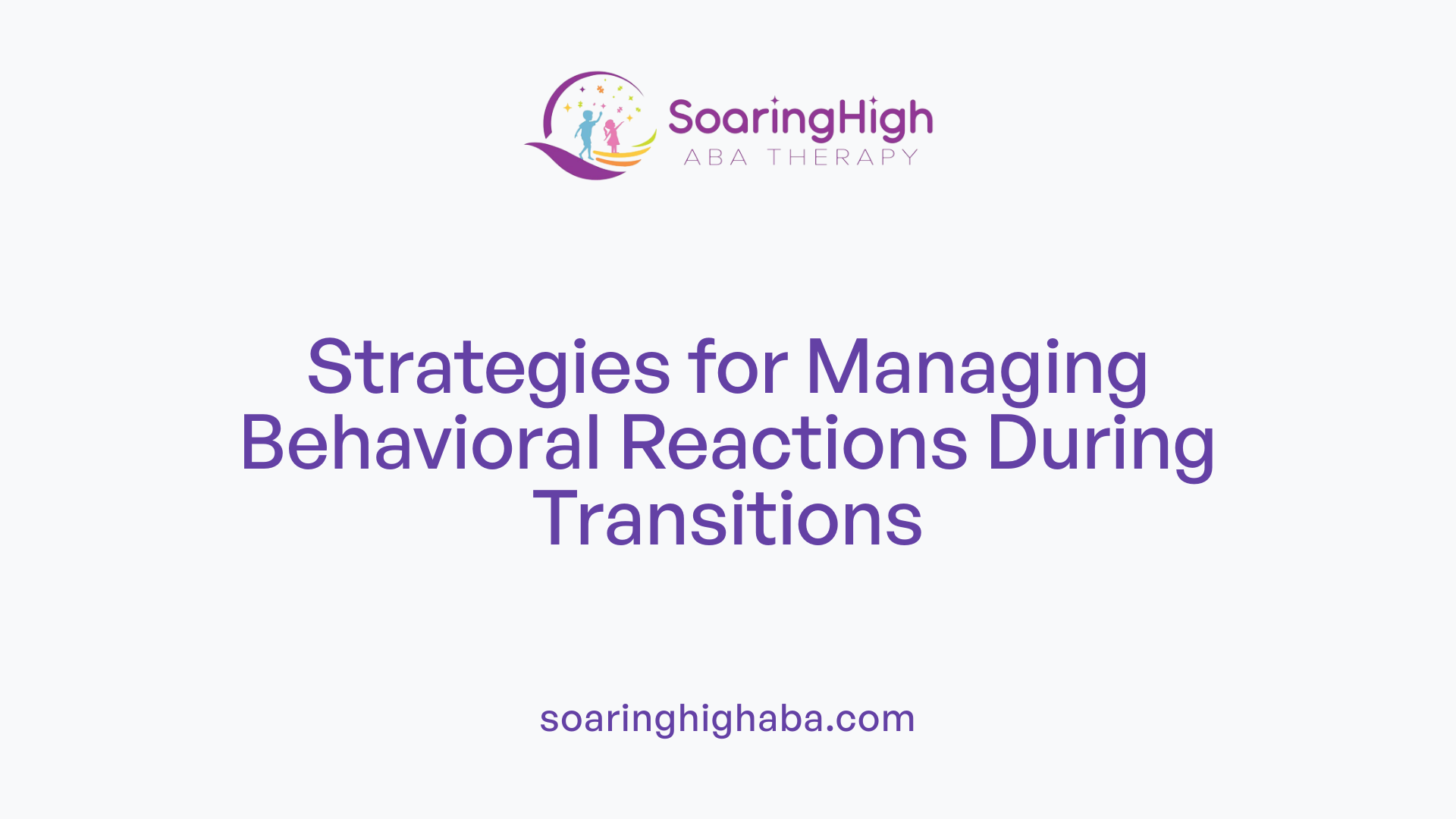Understanding the Role of ABA in Managing Change
Transitions and changes can be particularly challenging for children with autism, often inducing stress, anxiety, and behavioral difficulties. Applied Behavior Analysis (ABA) therapy offers a comprehensive approach that equips parents and caregivers with effective tools and strategies to support children through these pivotal moments. By emphasizing predictability, consistency, and skill development, ABA fosters resilience and independence, making it an invaluable resource for navigating routine shifts, developmental phases, and educational transitions.
Core Strategies in ABA to Facilitate Smooth Transitions

How are visual supports used in ABA to support transitions?
Visual supports, such as schedules, timers, and countdowns, are fundamental tools in ABA therapy for managing transitions. These visual cues help children grasp what is coming next and understand the sequence of activities. For example, picture schedules utilize images to outline daily routines, empowering children to anticipate changes in their day. Timers and countdowns further aid by providing a visual representation of time remaining before a transition occurs, which fosters a sense of predictability and reduces anxiety. The consistent use of these supports creates a structured environment, making changes less overwhelming and helping children feel more secure.
What role do social stories play in transition management?
Social stories are personalized narratives crafted to prepare children for upcoming changes by explaining social expectations in a clear, simple manner. These stories depict scenarios related to transitions, such as moving from school to home or starting a new activity, in a way that is easy to understand. By reading these stories beforehand, children gain a better grasp of what to expect and how to behave, which diminishes uncertainty and anxiety. Social stories effectively promote cooperation and positive behavior by framing routines and transitions as manageable and predictable.
Why is offering choices important during transitions?
Offering options during transitions helps children feel a sense of control, which can reduce resistance and emotional reactions linked to change. For example, allowing a child to choose between two different activities or decide the order of tasks encourages independence and cooperation. This strategy empowers the child, giving them a sense of agency and involvement, which can make transitions smoother. When children feel they have some say in the process, they are more likely to approach changes with a positive attitude, reducing stress and behavioral challenges.
How do consistency and familiar routines support transitions?
Maintaining consistent routines creates a stable environment that provides assurance to children with autism. Using familiar routines during periods of change, like Spring Break, helps minimize disruptions and uncertainty. When routines are predictable and reinforced across home, school, and community settings, children develop a sense of security. This consistency reduces anxiety and helps children adapt more easily to new circumstances or unusual schedules, promoting emotional regulation and smoother transitions.
What is the importance of positive reinforcement during transitions?
Positive reinforcement involves rewarding successful engagement with transition tasks, which fosters motivation and persistence. By offering praise, tokens, or other rewards when a child manages a transition well, caregivers and therapists reinforce adaptive behaviors. This not only encourages repeated use of effective strategies but also helps build positive associations with change. When children experience success and recognition during transitions, they are more likely to approach future changes with confidence and less resistance.
Preparing Children for Routine and Developmental Changes

How can parents prepare children ahead of time for changes?
Parents play a vital role in helping children with autism navigate routine and developmental changes. One effective method is using visual schedules that depict daily activities through pictures or words, helping children understand upcoming transitions. Social stories are another valuable tool; these are specially crafted narratives that explain what will happen during a change, offering reassurance and context.
Visual cues like timers or countdowns also assist children in anticipating when a change will occur. This preparation reduces anxiety and resistance by creating predictability. Gradual exposure to new environments, such as visiting a new place beforehand, or practicing routines multiple times leads to smoother transitions and builds confidence.
Overall, consistent communication, advance planning, and using visual supports foster a sense of security, making transitions less stressful for children with autism.
Empowering Children and Parents for Successful Transitions

How does teaching flexibility benefit children during transitions?
Teaching flexibility through small, gradual changes helps children adapt more easily to new routines and environments. By encouraging problem-solving and resilience, children learn to handle unexpected shifts without becoming overwhelmed.
Implementing incremental adjustments, such as slight changes in daily routines or activities, builds their comfort level and reduces resistance. This approach makes transitions less stressful and promotes confidence in managing future changes.
Therapists often encourage practices like introducing new tasks gradually or varying activities in a predictable way, allowing children to develop adaptability at their own pace.
What is the importance of reinforcement during transitions?
Reinforcement plays a vital role in helping children successfully navigate routines. When children experience positive outcomes after a transition—like praise, tokens, or preferred activities—they form associations that make future changes easier.
Using positive reinforcement encourages desired behaviors and increases motivation to cooperate during transitions. It helps children see change as manageable and even rewarding.
For example, rewarding a child with a favorite activity after completing a transition task reinforces the behavior and fosters a positive attitude towards future changes.
How can parents foster independence during routine changes?
Parents can support autonomy by offering choices whenever possible, such as selecting a snack or choosing between activities. This involvement helps children feel a sense of control and builds decision-making skills.
Encouraging children to participate in creating routines, like making visual schedules or planning activities, promotes ownership and confidence. Teaching self-regulation strategies, like calming techniques or waiting skills, further enhances independence.
Providing opportunities for children to practice routines, guided by supportive feedback, reinforces their ability to manage change independently and with less stress.
Monitoring behavior and adjusting plans
Regular observation of how a child responds to routines and transition strategies is crucial. Caregivers and therapists should assess what works well and where challenges arise.
Flexibility in planning allows for modifications, like adding additional visual supports or adjusting schedules to suit individual needs. This ongoing process of assessment and adjustment ensures that transition strategies remain effective and responsive.
Ultimately, consistent communication among caregivers, teachers, and therapy providers supports a coordinated approach, fostering a stable environment where children can thrive amid changes.
Supporting Transitions from ABA to Educational Settings and Beyond

Developing skills for school readiness
ABA therapy emphasizes building essential skills such as communication, social interaction, self-care, and routine-following. These abilities are crucial for children to succeed in classroom environments, participate actively in activities, and develop self-regulation skills. Tailored interventions using visual schedules, social stories, and task analysis help children prepare for the structured setting of school.
Collaboration with teachers and schools
A coordinated approach involving parents, ABA providers, and educators enhances the transition process. Pre-meetings and ongoing communication ensure that everyone shares pertinent information, including communication systems, behavior management strategies, and instructional methods. This teamwork ensures consistency across settings and helps customize supports to the child's needs.
Sharing information and resources
Effective transition planning relies on detailed sharing of relevant data—such as progress reports, behavior plans, and preferred communication tools. Materials like visual schedules and sign dictionaries should be prepared in advance and explained to school staff. This sharing promotes familiarity and facilitates smoother adjustment.
Addressing behavioral challenges in education
Behavioral support strategies from ABA, like positive reinforcement, visual cues, and structured routines, are implemented to manage behavioral challenges during school transitions. Planning for potential difficulties, including safety protocols and behavioral interventions, helps create a supportive learning environment.
Transition planning and Individualized Education Programs (IEPs)
IEPs are vital tools for coordinating transition efforts. They outline tailored goals, accommodations, and support services aligned with ABA strategies. Pre-meetings among families, ABA providers, and school staff are essential for developing comprehensive IEPs that address safety, behavioral goals, and skill development, ensuring a seamless educational journey.
| Aspect | Focus | Details |
|---|---|---|
| Skills for school | Communication, routines, self-care | Building independence in daily activities |
| Collaboration | Family, ABA, school teams | Planning, consistent implementation |
| Information sharing | Progress data, behavior plans | Visual supports, instructional materials |
| Behavioral management | Positive reinforcement, visual cues | Preemptive strategies and plans |
| Transition planning | IEP development | Goals, accommodations, training |
Supporting children with autism through targeted ABA strategies and collaborative efforts helps foster confidence and independence, easing the path from therapy into successful educational experiences and beyond.
Addressing Behavioral Challenges During Transitions

How can parents address negative reactions during transitions?
Parents play a crucial role in helping children manage their reactions to change. It is important to validate children’s feelings, acknowledging their stress and discomfort. Using calming techniques such as deep breathing exercises, sensory tools like fidget toys, or calming music can help soothe children during moments of distress.
Visual aids, including social stories and visual schedules, are effective tools that help children understand upcoming changes and manage their expectations. Explaining what will happen next in a reassuring tone can decrease anxiety and reduce negative behaviors.
What strategies support emotional regulation during transitional periods?
Teaching children specific coping skills fosters emotional resilience. Sensory breaks—time allocated for calming activities—can help children self-regulate before, during, or after transitions. Visual cues, such as countdown timers or picture-based warnings, prepare children for upcoming changes.
Creating a safe and predictable environment encourages stability. Reinforcing positive behaviors and responses with praise or reward reinforces self-regulation. Providing safe spaces where children can retreat when overwhelmed further supports emotional regulation.
How important is flexibility in managing behavioral responses?
Flexibility is vital in managing transitions effectively. Caregivers and educators should be prepared to adjust their plans based on how the child responds in real-time. If a child's behavior escalates, changing the approach or offering alternative calming strategies can prevent further distress.
Monitoring responses actively allows adults to identify what strategies are working and when adaptations are needed. This flexible approach not only helps de-escalate challenging behaviors but also builds trust and confidence in children as they learn to handle change.
By combining validation, calming strategies, visual supports, and flexibility, families and professionals can support children through transitions, reducing anxiety and fostering emotional well-being.
Long-Term Benefits and Independence Building
 ABA therapy is instrumental in fostering lifelong skills that extend well beyond childhood. One of its core objectives is to equip individuals with autism with critical competencies such as independence, social skills, and self-management abilities. These skills are fundamental for a successful transition to adulthood, enabling individuals to navigate community life more effectively.
ABA therapy is instrumental in fostering lifelong skills that extend well beyond childhood. One of its core objectives is to equip individuals with autism with critical competencies such as independence, social skills, and self-management abilities. These skills are fundamental for a successful transition to adulthood, enabling individuals to navigate community life more effectively.
During the transition to adulthood, ABA programs tailor interventions to develop practical life skills like personal care, managing finances, and using public transportation. By incorporating real-world practice and setting personalized goals, ABA helps individuals gain confidence and competence in everyday activities. This approach promotes greater autonomy and prepares them for various community roles.
Support for independence and community participation doesn't stop at skill-building. ABA interventions often include collaboration with local resources, employment programs, and social groups. These partnerships expand opportunities for vocational training and social engagement, fostering a sense of belonging and purpose.
Families play a crucial role in sustaining progress through ongoing support networks. Resources such as advocacy organizations, community services, and parent support groups provide emotional backing, educational materials, and guidance for long-term planning. These networks empower families to advocate effectively for their children's needs and ensure continuous developmental support.
In summary, ABA’s focus on lifelong skills development and community integration assists individuals with autism in leading more independent and fulfilled lives. Through targeted intervention, collaboration, and resource accessibility, ABA helps bridge the gap from childhood independence to active adult participation.
The Role of Data Collection and Ongoing Assessment in Transition Support

How does ongoing assessment enhance transition planning?
Consistent data collection and assessments are vital tools in planning successful transitions for children with autism. They allow therapists and educators to monitor progress closely, pinpoint which strategies are effective, and spot any emerging needs early on. Regularly reviewing this information helps tailor interventions to the child's current abilities and challenges.
An essential part of this process involves using visual tools like graphs, which clearly depict the child's developmental trajectory over time. These visualizations aid families and teachers in understanding how well goals are being met and whether modifications are necessary. The clarity provided by graphs supports collaborative decision-making and ensures that strategies remain relevant and effective.
Why is family involvement important in progress evaluation?
Engaging families in ongoing assessments keeps the focus on real-world applicability. Families observe children in natural environments and can provide critical insights into behaviors outside the therapy setting.
Their feedback helps ensure that intervention goals are meaningful and aligned with daily life concerns and routines. Moreover, involving families promotes consistency across home and school environments, reinforcing learning and adaptive skills.
How do data-driven adjustments improve transition success?
When interventions are guided by data, support is more targeted and precise. For example, if assessments reveal hesitation or difficulty with specific transitions, therapists can adjust strategies—such as increasing visual supports or practice sessions—to address these issues directly.
This responsiveness leads to smoother transitions, reduced anxiety, and greater confidence in handling change. Ultimately, data-driven adjustments foster a more adaptable approach, supporting children as they develop independence and resilience during life changes.
| Aspect | Description | Supporting Tools |
|---|---|---|
| Monitoring progress | Tracking growth through assessments and observations | Assessments, ongoing observations |
| Visualizing data | Using graphs to illustrate progress clearly | Line graphs, bar charts |
| Family involvement | Gathering parent feedback for comprehensive evaluation | Parent interviews, feedback forms |
| Adaptive strategies | Modifying interventions based on collected data | Data analysis, flexible planning |
Supporting Families for Long-Term Success
Effective management of transitions is crucial for the well-being and development of children with autism. ABA therapy offers tailored strategies, proactive preparation, and collaborative approaches that empower parents, enabling smoother changes and fostering resilience. By focusing on skill-building, positive reinforcement, and continuous assessment, ABA sets a foundation for lifelong independence and social success, ensuring that children are supported both in the immediate process of transition and throughout their journey into adulthood.
References
- Transitioning to Spring Break: ABA Tips for a Smooth Transition
- Helping Kids with Autism Adapt to Routine Changes
- Advances in Supporting Parents in Interventions for Autism ...
- Transitioning to Adulthood: How ABA Can Help
- Effective Techniques to Help Children with Autism Manage Transitions
- How ABA Therapy Improves Transition Skills in Children with Autism
- Transition Checklist: Moving From ABA Programs to School Programs
- How ABA Therapy Helps Autistic Children Manage Transitions
- 7 Essential Self Management Strategies for ABA Therapy Success
- Transition Time: Helping Individuals on the Autism Spectrum Move ...





































































































